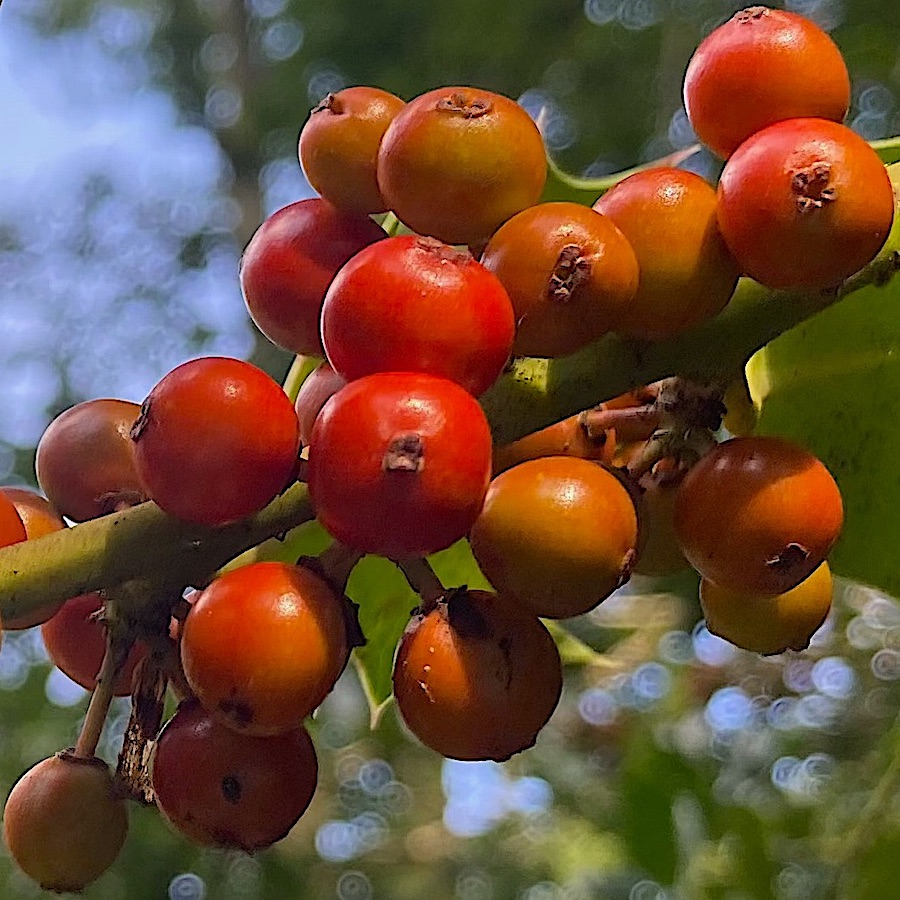
“Deck the halls with boughs of holly”…Perhaps the favourite plant for Christmas decorations, Holly is also one of our most familiar woodland shrubs. Look out for its evergreen leaves on The Lizard throughout the year.
Photo: Amanda Scott
Scientific name: Ilex aquifolium
Other common names: Hulver, Holm, Hollin
Cornish name: Kellinan
What to look for:
- Family: Aquifoliaceae (Holly)
- Flowers: Small white flowers with four petals. Male flowers have four stamens, and female four carpels.
- Leaves and stem: Leaves are arranged alternately, and are dark green and glossy, with waxy feel, and toothed round edges. Bark is smooth.
- Berries: Scarlet in small clusters on female trees.
- Height: Can reach 15 m.
- Where: Very common across Britain, except for the Scottish Highlands. Overall distribution is mainly north-west Europe.
- When: Flowers between May and August; berries appear in the winter.
- Habit: Small shrub/tree.



In a land where many of our native shrubs and trees are deciduous, Holly stands out, alongside its Christmas carol partner, Ivy. Its glossy evergreen and spiky leaves, and the fact it is a common plant of woodlands and scrub, mean that it became a symbol of life and hope in the midst of winter. Today, it remains probably the most popular plant for Christmas decorations. In Cornwall, it was once traditionally used rather than a Christmas tree.
Holly was adopted by Christian tradition, but its folklore history goes back to much earlier, long before the first church missionaries set foot here. It was believed to ward off evil spirits, lightning and fire, and to bring good luck. But its evergreen nature gave it many practical as well as mystical uses. In particular, it was often used as a boundary marker, or to mark things such as stiles. Holly shrubs were recorded as being planted to mark the course of the lode associated with Wheal Pool near Helston after it closed.
Holly is dioecious, meaning it has separate male and female plants. If you are growing Holly trees in your garden as ornamentals, then you need both male and female plants for cross-pollination if you want bright scarlet berries in winter. In the wild, it is mainly associated with Beech and Oak woodlands, and is an ancient woodland indicator.
Did you know…?
…The leaves at the top of Holly trees are usually spineless. The spines have evolved as a deterrent to browsing predators such as deer, so there is no need for spines on leaves that are out of their reach.
…In the late eighteenth to nineteenth centuries, Holly was used extensively to make horsewhips. As well as having the right properties of pliability to make a good whip, folklore tells us that Holly has magical power over horses.
More information and references:
Baker, M., 1928 (reprinted 2001). Discovering the Folklore of Plants. Shire Publications Ltd., Buckinghamshire.
Mabey, R., 1997. Flora Britannica. Chatto & Windus, London.
Rose, F. and O’Reilly, C., 2006. The Wild Flower Key, 2nd edition. Frederick Warne, London.
Stace, C., 2010. New Flora of the British Isles, 3rd edition. Cambridge University Press, Cambridge.
Published: December 2014
Author: Amanda Scott
Photos: Amanda Scott; apart from Holly flowers – Steve Townsend
